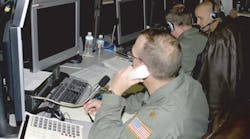WASHINGTON - The value of unmanned aerial vehicles (UAVs) to provide situational awareness in combat is well established. They can go where man cannot go - saving lives in the process - and return valuable real-time data on enemy strengths and movements.
What has been missing up until now has been a way to correlate that information with the terrain, and here is a primary opportunity for commercial off-the-shelf (COTS) technology.
U.S. military forces have been correcting that deficiency with a program to use COTS hardware and software from Sarnoff Corp. in Princeton, N.J.
Under sponsorship of the Air Force’s Battle Laboratory at Eglin Air Force Base, Fla., and in flight demonstrations using the Predator and Shadow UAVs at Fort Huachuca, Ariz., the technique has advanced sufficiently enough for the U.S. Marine Corps to begin using it in Iraq.
The basic concept is to correlate the live video data from the UAVs with terrain information derived from satellites and other sources and put the whole picture on a standard COTS television monitor for the battlefield commanders.
The role of Sarnoff is particularly significant because the company can draw on more than 60 years of computer technology. Originally founded in 1942 as the research arm of RCA Corp. during that company’s ill-fated attempt to compete with IBM during the pre-personal computer days, Sarnoff has since been spun off as a wholly owned subsidiary of SRI International in Menlo Park, Calif., to achieve a certain synergism in health care and consumer, as well as defense and security.
Sarnoff officials unveiled the UAV application in September at this year’s Air Force Association annual convention in Washington, and the company is now marketing it. As described by Sarnoff’s Mark Sartor, senior director of business development, and Donald Channin, business manager, the product is essentially a software package that doesn’t care what kind of COTS monitor it uses.
The idea is to zoom in on the Earth’s surface to within “several square miles” (for security reasons, Sartor and Channin are not saying how many miles) and create a three-dimensional image on the computer monitor.
All of this is in real time, so that a commander can call in an air strike as needed. This involves generating map coordinates in ways that could not have been done before. The applications to date have used ruggedized 19-inch racks, all made of COTS hardware, but the images could just as well be shown on laptop or suitcase computers in an office environment for the higher echelons in headquarters operations.
The next step, according go the Sarnoff executives, is to work with the Boeing Co., based in Chicago, to tailor the technique to that company’s Scan Eagle UAV being developed for the Marine corps.
In a way, this correlation technique represents the missing piece in the jigsaw puzzle of greater use of UAVs in surveillance. Given the current security environment, greater reliance on surveillance seems almost certain.
This kind of surveillance capability is valuable not just for opposing combat forces. It would certainly be useful to monitor - and pinpoint the locations of - facilities used to develop weapons of mass destructions (WMDs). The WMD problem isn’t about to go away anytime soon, and military forces will need all available tools to support what could prove to be an alternative to combat.
The heart of this capability is the existing COTS base. Unlike the carbon-based operators of reconnaissance aircraft, which have evolved as far as they are likely to evolve, the silicon-based sensors in the UAVs continue to improve across the board for military and commercial applications.
In that regard, it’s useful to cite the current status of Moore’s Law. That law, formulated by Intel founder Gordon Moore and well known to readers of this magazine, states that processing power at the chip level doubles every 18 months with no increase in price (actually it was originally stated as two orders of magnitude per decade, but the arithmetic is about the same, and the current version is probably easier to understand for people who are uncomfortable with scientific notation).
That progress has tracked with amazing precision for the past 50 years, and is likely to do so for another 10 years. After that time, however, recent estimates call for it to taper off to a doubling every 36 months, again with no increase in price.
That still makes computer solutions attractive for the foreseeable future, and here is where the military can exploit COTS to its full potential.
In their presentation at the Air Force Association meeting, Sarnoff executives stressed the nonmilitary applications currently in early stages of development.
Electronics is poised to revolutionize pharmaceutical and genetic research, diagnostic procedures, and health care, according to the Sarnoff executives. Sarnoff is already claiming what it calls breakthroughs in medical imaging, disposable hearing aids, handheld diagnostics, and home health-care devices. These applications share a technology base with consumer electronics and displays.
What I found impressive about Sarnoff’s presentation at the Air Force Association meeting is the multidisciplinary - rather than corporate research laboratory - approach that company researchers are taking in their academic environment of Princeton, N.J. The linkage is there; it’s simply a matter of exploiting it.
With all the recent controversy over the military actions in Iraq and the elusive WMDs, it borders on the ironic how the Iraq conflict in the future may come to be regarded as a milestone in the application of advanced electronics technology to create the safer, healthier world that everybody is seeking.


